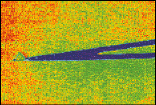Polarized Light Makes Special Glass Grow
R. Winn HardinCAMBRIDGE, UK -- Science has pursued organic polymers in the quest for light-powered, nano-size switches, motors and pumps. Now, researchers at the University of Cambridge have developed an inorganic glass that expands and contracts in response to polarized light.

The same optically induced pressure that bent this atomic force microscope cantilever could be used to create nanoswitches. |
"There's a number of industrial applications that people are calling us about," he said. Among those under consideration is a light-powered arm for the read/write heads that float above computer disks.
According to the researchers, glass expands when exposed to light. This effect, known as scalar change, is an isotropic phenomenon that occurs uniformly regardless of polarization. Vectoral changes occur in a specific direction, either parallel or perpendicular, to the polarization of the electric fields in a beam of light.
In their experiment, the researchers tested the glass by depositing a thin film of arsenic and selenium on one side of a 200-µm- long cantilever used in atomic force microscopy. A laser, bouncing off the back of the cantilever and captured by a position-sensitive photodiode, allows the microscope to detect submicron movements in the cantilever.
Instead of mapping the surface of a material, however, the scientists measured the upward and downward movements of the cantilever while switching the polarization of the light. To ensure that the changes were not caused by scalar effects, they first saturated the glass with circularly polarized light using a HeNe laser fed through an optical fiber. An electro-optic modulator switched the beam from circularly polarized to vertically and then orthogonally polarized light.
The researchers detected 1-nm movements as they switched from circular (equilibrium) to horizontal (upward movement) to vertical (downward movement) polarization.
LATEST NEWS
- AmeriCOM Adds President and CEO: People in the News: 5/1/24 May 1, 2024
- Machine Learning Pushes High-Power Lasing Limits May 1, 2024
- IPG Names Industry Veteran Mark Gitin CEO Apr 30, 2024
- 16th Biannual Optatec Conference Continues in Frankfurt Apr 30, 2024
- Celestial Surface Mapping Tech Combines Established Techniques Apr 30, 2024
- TSMC Partnerships Target Integrated Photonics Capabilities Apr 30, 2024
- CLEO Heads to the East Coast Apr 29, 2024
- Qubits Could be Stored in Flash-Like Memory Apr 29, 2024
